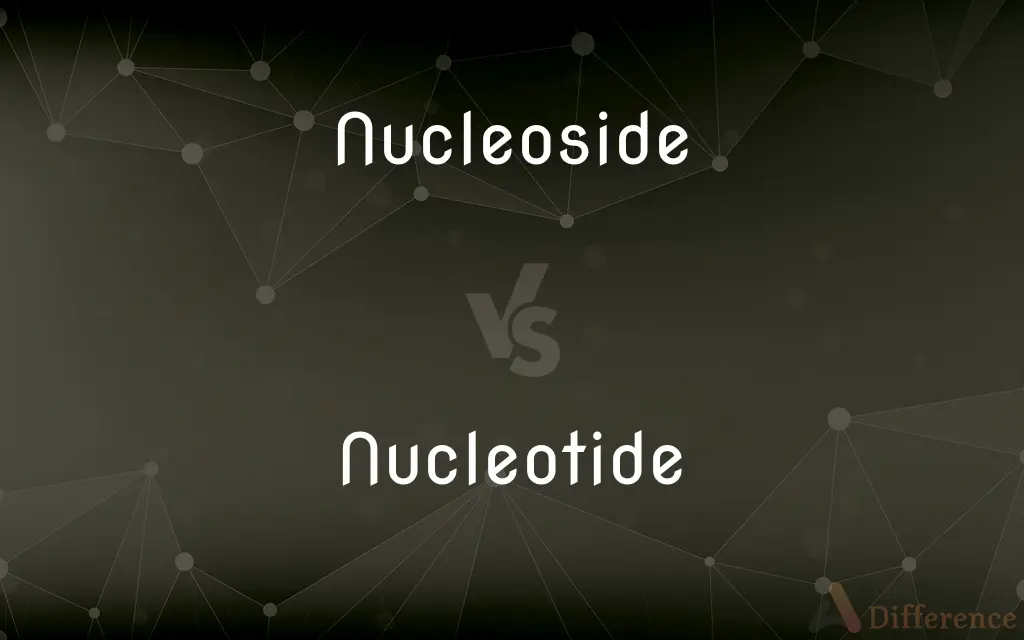Nucleoside vs. Nucleotide — What's the Difference?
By Tayyaba Rehman — Updated on September 22, 2023
A Nucleoside consists of a sugar and a base, while a Nucleotide includes a sugar, a base, and one or more phosphate groups. Both are vital in genetic material, but Nucleotides are the building blocks of DNA and RNA.

Difference Between Nucleoside and Nucleotide
Table of Contents
ADVERTISEMENT
Key Differences
A Nucleoside and a Nucleotide are fundamental molecules in biology, especially in the context of DNA and RNA. A Nucleoside is made up of a sugar molecule (either ribose or deoxyribose) attached to a nitrogenous base (either a purine or pyrimidine). This combination of sugar and base is integral to the formation of the genetic code.
On the other hand, a Nucleotide is essentially a Nucleoside that has one or more phosphate groups attached to its sugar component. This addition of phosphate groups makes Nucleotides the primary building blocks of nucleic acids like DNA and RNA. When these Nucleotides link together in a sequence, they form the strands of DNA or RNA that store genetic information.
In essence, a Nucleoside can be thought of as a "partial" Nucleotide. Without the phosphate group(s), a Nucleoside cannot form the backbone chain of nucleic acids. However, both Nucleosides and Nucleotides play crucial roles in various biological processes. For instance, some Nucleosides act as coenzymes or are involved in metabolic pathways.
It's also worth noting that while all Nucleotides contain Nucleosides, not all Nucleosides are part of Nucleotides. This distinction between the two, primarily the presence or absence of the phosphate group(s), is vital for understanding the structure and function of genetic material.
Comparison Chart
Components
Sugar and base.
Sugar, base, and one or more phosphate groups.
ADVERTISEMENT
Role in DNA/RNA
Intermediate molecule.
Building blocks of DNA and RNA.
Presence of Phosphate
No.
Yes.
Chemical Structure
Simpler.
More complex due to additional phosphate groups.
Biological Functions
Coenzymes, metabolic pathways.
Form nucleic acids, energy transfer, signaling.
Compare with Definitions
Nucleoside
A molecule formed from a nitrogenous base and a sugar.
Adenosine is a Nucleoside composed of adenine and ribose.
Nucleotide
A building block of nucleic acids containing a sugar, base, and phosphate.
DNA is made of Nucleotide sequences that encode genetic information.
Nucleoside
An intermediate in the synthesis and degradation of nucleic acids.
Certain drugs target viral Nucleosides to halt replication.
Nucleotide
A fundamental unit in genetic transcription and translation.
Each Nucleotide in RNA pairs with a complementary partner during translation.
Nucleoside
A compound involved in various cellular functions.
Some Nucleosides have roles outside of nucleic acid synthesis.
Nucleotide
A molecule derived from a Nucleoside by adding phosphate groups.
ATP, a key energy molecule, is a triphosphate Nucleotide.
Nucleoside
A precursor molecule to Nucleotides.
Without a phosphate group, a Nucleoside cannot become a Nucleotide.
Nucleotide
An essential component in cellular energy transfer.
Nucleotides like ATP and GTP are central to cellular metabolism.
Nucleoside
A structural unit of certain coenzymes.
NAD+ has an adenosine Nucleoside within its structure.
Nucleotide
Nucleotides are organic molecules consisting of a nucleoside and a phosphate. They serve as monomeric units of the nucleic acid polymers – deoxyribonucleic acid (DNA) and ribonucleic acid (RNA), both of which are essential biomolecules within all life-forms on Earth.
Nucleoside
Nucleosides are glycosylamines that can be thought of as nucleotides without a phosphate group. A nucleoside consists simply of a nucleobase (also termed a nitrogenous base) and a five-carbon sugar (ribose or 2'-deoxyribose) whereas a nucleotide is composed of a nucleobase, a five-carbon sugar, and one or more phosphate groups.
Nucleotide
A compound consisting of a nucleoside linked to a phosphate group. Nucleotides form the basic structural unit of nucleic acids such as DNA.
Nucleoside
Any of various compounds, such as adenosine or guanosine, that consist of a sugar, usually ribose or deoxyribose, linked to a purine or pyrimidine base. Nucleosides are constituents of the nucleotides that make up nucleic acids.
Nucleotide
Any of a group of compounds consisting of a nucleoside combined with a phosphate group and constituting the units that make up DNA and RNA molecules.
Nucleoside
(biochemistry) an organic molecule in which a nitrogenous heterocyclic base (or nucleobase), which can be either a double-ringed purine or a single-ringed pyrimidine, is covalently attached to a five-carbon pentose sugar (deoxyribose in DNA or ribose in RNA). When the phosphate group is covalently attached to the pentose sugar, it forms a nucleotide.
Nucleotide
(biochemistry) The monomer constituting DNA or RNA biopolymer molecules. Each nucleotide consists of a nitrogenous heterocyclic base (or nucleobase), which can be either a double-ringed purine or a single-ringed pyrimidine; a five-carbon pentose sugar (deoxyribose in DNA or ribose in RNA); and a phosphate group.
Nucleoside
A type of molecule found in all living organisms, present mostly in chemically combined form as a component of nucleic acids, and also in smaller amounts in free form, consisting of a pentose sugar bound to a purine or pyrimidine base; two types of nucleoside, ribonucleoside and deoxyribonucleoside, are present. The most common bases present in nucleosides are adenine, cytosine, uracil, guanine, and thymine, and to a lesser extent hypoxanthine and other bases are found. The most commmon ribonucleosides composed from these bases are called adenosine, cytidine, uridine, and guanosine. The forms esterified with orthophosphoric at the 5-position of the pentose are called nucleotides. The nucleotides form the monomer units which are combined into DNA and RNA, which carry the genetic information required for reproduction in all known organisms.
Nucleotide
A phosphate ester of a nucleoside; one of the monomeric components of DNA or RNA.
Nucleoside
A glycoside formed by partial hydrolysis of a nucleic acid
Nucleotide
A phosphoric ester of a nucleoside; the basic structural unit of nucleic acids (DNA or RNA)
Nucleotide
A molecule involved in cellular signaling and regulation.
Cyclic AMP is a Nucleotide that acts as a secondary messenger in cells.
Common Curiosities
Can a Nucleoside be converted to a Nucleotide?
Yes, by adding one or more phosphate groups to a Nucleoside, it becomes a Nucleotide.
Which molecule is central to forming DNA strands: Nucleoside or Nucleotide?
Nucleotide, as it forms the backbone of nucleic acids like DNA.
Do Nucleosides have roles outside of forming Nucleotides?
Yes, some Nucleosides act as coenzymes or participate in metabolic pathways.
Can a Nucleotide exist without a Nucleoside?
No, a Nucleoside is an integral part of a Nucleotide.
Are all Nucleotides derived from Nucleosides?
Yes, every Nucleotide originates from a Nucleoside with added phosphate group(s).
Why is the phosphate group essential in a Nucleotide?
The phosphate group allows Nucleotides to link together, forming the structure of DNA and RNA.
Are Nucleotides involved in energy transfer?
Yes, Nucleotides like ATP are central to cellular energy transfer.
Do both Nucleosides and Nucleotides play roles in genetics?
Yes, while Nucleotides form genetic material, Nucleosides are involved in various genetic processes.
How does a Nucleoside differ from a Nucleotide?
A Nucleoside lacks the phosphate group(s) present in a Nucleotide.
Which has a simpler structure: Nucleoside or Nucleotide?
Nucleoside, as it lacks the complexity of additional phosphate groups.
Share Your Discovery

Previous Comparison
Entire vs. Intire
Next Comparison
Tew vs. TowAuthor Spotlight
Written by
Tayyaba RehmanTayyaba Rehman is a distinguished writer, currently serving as a primary contributor to askdifference.com. As a researcher in semantics and etymology, Tayyaba's passion for the complexity of languages and their distinctions has found a perfect home on the platform. Tayyaba delves into the intricacies of language, distinguishing between commonly confused words and phrases, thereby providing clarity for readers worldwide.















































